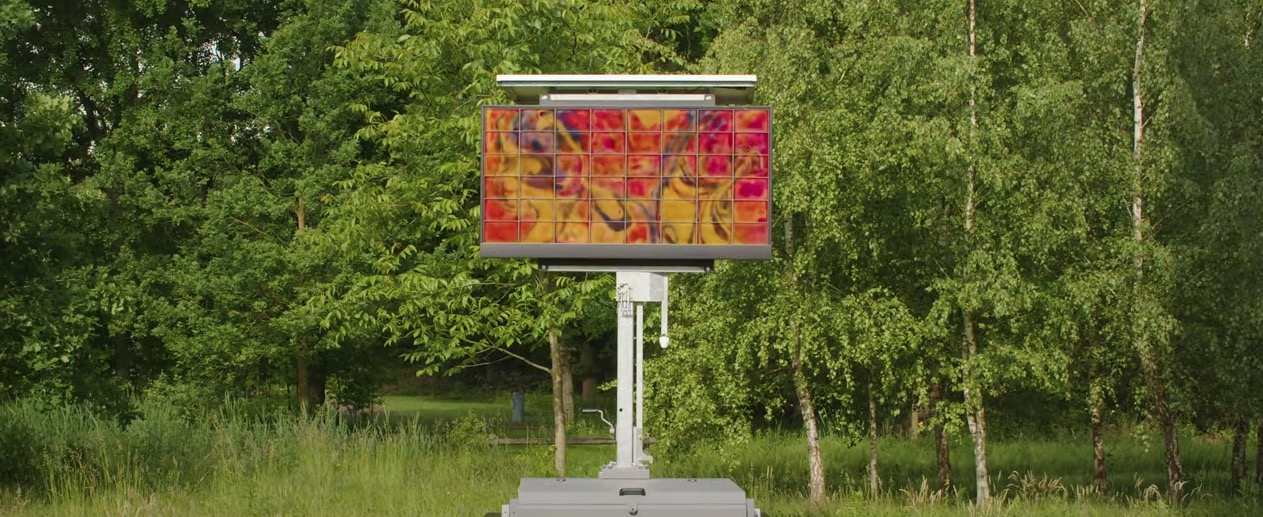
Daktronics Actively Testing Large Format, Fill Color Outdoor E-paper Displays With Dutch Firm Etulipa
June 29, 2022 by Dave Haynes
LED display giant Daktronics is part of a small consortium actively testing a new kind of reflective epaper display that supports full color and video, and works reliably outdoors.
The electro wetting display display technology was developed by a small Dutch company, Etulipa, and is being tested and evaluated both in South Dakota (where Dak is based) and in Eindhoven, in the Netherlands. The third member of the consortium is United Radiant Technology Corporation, a Taiwanese manufacturer of professional LCD panels and modules.
The main value proposition of this technology is energy savings, with billboards and ad posters requiring only a fraction of the power usage of more conventional digital messaging displays. The Etulipa displays harvest solar power through a day and are illuminated by reflecting natural light, and use backlighting for overnight and low-light conditions (just like ereaders used in dark rooms).
Says Etulipa in announcing the start of evaluations:
Averaged over day and night, Etulipa full color displays consume only 7 Watts per sqm., tens of times less than the usual digital outdoor displays so that displays can be installed without being connected to the electricity network. That saves costs and time.
The reflective properties imply that there is no light pollution. This makes this display perfectly in line with everyone’s pursuit of greater sustainability so that applying for a permit will be much easier.
Etulipa’s displays are based on its patented 2nd generation EWD technology. Electronic paper (ePaper) displays like these use the ambient light that falls on the display surface and reflect it back to the eye of the observer, resulting in excellent readability under all conditions. Since reflective displays do not emit light but reflect it, they create zero light pollution, are not intrusive, and produce zero emissions. In very low light conditions, like night without street lighting, a backlight lights up the display enough to create same saturated colors as in day light.
The market for digital displays has been growing for years. At the same time, many consumers have a desire to lower their energy use and become better stewards of our environment,” says Hans Feil, CEO of Etulipa. “We believe this will drive interest in new kinds of displays with the smallest possible ecological footprint. I am happy that we now show our colors to the world for the first time and demonstrate that there is a sustainable alternative in the world of digital outdoor communication. I am convinced that Etulipa’s Electro Wetting Displays will play an important role in the future of outdoor communication”.
Feil production in larger quantities will start after the evaluation period. The obvious qualifier there is that the eval process goes well.
This is quite interesting. The video below shows that the visuals are decent for a working prototype. There are seams between the display units but the company says those will narrow and start to minimize. The Taiwan-US firm E ink is the biggest name in electronic paper, and has been working for many years to improve support for color and for motion graphics. Outdoor applications using their e-paper have tended to be monochromatic and static, for things like local directories and updated transit schedules at stops. I have seen E Ink video, and it was pretty rough (though that’s going back to 2019).
Etulipa says what it is doing is distinct from more familiar e-paper technology.
It says Electro Wetting Display (EWD) technology is a type of ePaper technology, distinct from electrophoretic technology. They are both reflective but the product characteristics are not the same.
With electrophoretic pixel, black and white pigment particles with opposite charges migrate inside capsules, depending on the applied voltage. With EWD, the pixels are made up of cells containing colored or black oil and a transparent electrolyte. “EWD technology relies on the surface tension of the liquids and uses a low, applied voltage to cause the oil to spread or contract. When the oil is contracted, light is reflected from the white reflector behind the cells.”
“The Etulipa EWD technology is by its nature suitable for full color, video and outdoor use. That makes the colors brighter. The EWD-displays are all weather-proof with very wide operating temperature range of -30C to +65C.”
There are many, many, many R&D projects happening around the world involving display technology – everything from microLED and quantum dots for OLEDs to small epaper displays that reduce or eliminate hard-wired electrical connections and bills.
What’s interesting here is that Daktronics – one of the biggest manufacturers on the planet for conventional indoor and outdoor LED displays – is actively testing this. Energy conservation and green initiatives are much bigger deals in Europe and much of the rest of the world, but even in the United States billboard and ad network operators spend a lot of money not only on monthly energy bills, but on the initial costs to get power to some displays.
It might be somewhere down the road, but if Dak has the lead on a large format alternative to energy hungry displays, that keeps them on a consideration list when competitors might be ruled out in cost and green energy analyses.




Leave a comment